Themed collection Functional Framework Materials for Biomedical Applications

Functional framework materials for biomedical applications
Ross S. Forgan, Ruxandra Gref and Jianqiang Liu introduce the Journal of Materials Chemistry B themed collection on functional framework materials for biomedical applications.

J. Mater. Chem. B, 2024,12, 3567-3568
https://doi.org/10.1039/D4TB90022G
Functionalized ZIF-8 as a versatile platform for drug delivery and cancer therapy: strategies, challenges and prospects
This review discusses the functionalization strategies of ZIF-8 and challenges and future developments in ZIF-8-based platforms for drug delivery and cancer therapy.

J. Mater. Chem. B, 2025,13, 3758-3785
https://doi.org/10.1039/D4TB02289K
Advances in nanozymes with peroxidase-like activity for biosensing and disease therapy applications
This review explores the different types of nanozymes with POD-like activity and discusses their activity regulation, particularly emphasizing their latest development trends and advances in biosensing and disease treatment.

J. Mater. Chem. B, 2025,13, 1599-1618
https://doi.org/10.1039/D4TB02315C
Electrospun organic/inorganic hybrid nanofibers for accelerating wound healing: a review
This review summarizes fabrication strategies and manifold applications of electrospun organic/inorganic hybrid nanofibers in promoting the wound healing process.

J. Mater. Chem. B, 2024,12, 3171-3190
https://doi.org/10.1039/D4TB00149D
MOF magic: zirconium-based frameworks in theranostic and bio-imaging applications
Over the past two decades, metal–organic frameworks (MOFs) have garnered substantial scientific interest across diverse fields, spanning gas storage, catalysis, biotechnology, and more.

J. Mater. Chem. B, 2024,12, 2691-2710
https://doi.org/10.1039/D3TB02562D
Magnetic two-dimensional nanocomposites for multimodal antitumor therapy: a recent review
Magnetic 2D nanocomposites exhibit advanced antitumor applications, including magnetically targeted hyperthermia, drug delivery, phototherapy, nanozyme therapy, immunotherapy and multimodal imaging.
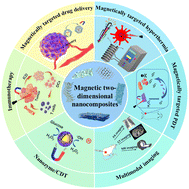
J. Mater. Chem. B, 2024,12, 1404-1428
https://doi.org/10.1039/D3TB02333H
A new era in cancer treatment: harnessing ZIF-8 nanoparticles for PD-1 inhibitor delivery
ZIF-8 nanoparticles, with large surface area and pore capacity, can be functionalized for targeted cancer treatment. This enhances chemotherapeutic drug efficacy and potentially improves PD-1 inhibitors’ effectiveness.

J. Mater. Chem. B, 2024,12, 872-894
https://doi.org/10.1039/D3TB02471G
Metal–organic framework-based platforms for implantation applications: recent advances and challenges
This review highlights the recent advances of MOFs and their related hybrids in main implant intervention fields, while also discussing their confronting challenges and future perspectives.

J. Mater. Chem. B, 2024,12, 637-649
https://doi.org/10.1039/D3TB02620E
The green synthesis and applications of biological metal–organic frameworks for targeted drug delivery and tumor treatments
Application and development of synthesized bio-MOFs via a green approach (solvent-free and solvent-based green syntheses) for targeted drug delivery and tumor treatment.

J. Mater. Chem. B, 2023,11, 11426-11459
https://doi.org/10.1039/D3TB01959D
A review of zeolitic imidazolate frameworks (ZIFs) as electrochemical sensors for important small biomolecules in human body fluids
The emergence of ZIFs-based composite materials as promising candidates for electrochemical sensors of important small biomolecules in human body fluids.

J. Mater. Chem. B, 2023,11, 9099-9127
https://doi.org/10.1039/D3TB01221B
Therapy and diagnosis of Alzheimer's disease: from discrete metal complexes to metal–organic frameworks
Critical analysis of discrete metal compounds and metal–organic frameworks (MOFs) as a platform for the treatment and/or diagnosis of Alzheimer's disease.

J. Mater. Chem. B, 2023,11, 7024-7040
https://doi.org/10.1039/D3TB00427A
Metal–organic frameworks (MOFs) as apt luminescent probes for the detection of biochemical analytes
This article reviews the recent developments in the use of MOF materials as probes and biosensing platforms for diverse chemicals (H2O2, metal ions, H2S, GSH, and nucleic acids) in biological cells.

J. Mater. Chem. B, 2023,11, 6802-6822
https://doi.org/10.1039/D3TB00505D
Metal–organic frameworks (MOFs) as effectual diagnostic and therapeutic tools for cancer
Metal–organic frameworks (MOFs) that comprise metal ions combined with assorted organic linkers have been utilized as tools in cancer therapy.

J. Mater. Chem. B, 2023,11, 6782-6801
https://doi.org/10.1039/D3TB00706E
Ligand-dependent activity engineering of Cu-MOFs based on biomimetic strategies for nanozyme-decorated smart hydrogels for therapy of inflammatory bone defects
Reconstructing inflammatory bone defects using stem cell-based therapy faces challenges posed by the oxidative stress microenvironment.

J. Mater. Chem. B, 2025,13, 12448-12468
https://doi.org/10.1039/D5TB01686J
Sodium alginate/polyvinylpyrrolidone/lapatinib-loaded Zr–metal organic framework: biocompatibility evaluation and pH-responsive in vitro drug release for oral delivery applications
pH-responsive sodium alginate/polyvinylpyrrolidone/Zr–metal organic framework composite for controlled lapatinib release and high biocompatibility in oral breast cancer therapy.

J. Mater. Chem. B, 2025,13, 12205-12223
https://doi.org/10.1039/D5TB01449B
Glucose oxidase immobilized on ZIF-7-III: composite formation, optimization and integration in an electrochemical biosensor for selective glucose detection
GOD@ZIF-7-III composites demonstrate 98% catalytic activity, improved pH and thermal stability, 66% storage retention, and efficient glucose detection in plasma, highlighting biosensing potential.

J. Mater. Chem. B, 2025,13, 11739-11749
https://doi.org/10.1039/D5TB01119A
Deposition of metal–organic frameworks within a porous protein crystal superstructure
A cartoon, theoretical representation of a highly porous protein crystal that has been subjected to MOF growth conditions, highlighting the union of both the proteinaceous components and MOF components of the hybrid material.

J. Mater. Chem. B, 2025,13, 10864-10870
https://doi.org/10.1039/D5TB00425J
Construct an “immunogenic cell death” amplifier based on Fe-MOFs by accelerating Fe(III) reduction strategies for integration of tumor diagnosis, treatment, and prevention
Traditional tumor treatments focus on treating the location of the lesion, while immunogenic cell death (ICD) triggers systemic anti-tumor immunity and inhibits tumor metastasis.

J. Mater. Chem. B, 2025,13, 7691-7704
https://doi.org/10.1039/D5TB00686D
ZIF-8/doxorubicin nanoparticles camouflaged with Cucurbita-derived exosomes for targeted prostate cancer therapy
Biomimetic ZIF-8/DOX nanoparticles, coated with Cucurbita-derived exosomes and functionalized with EpCAM aptamer, were developed to enhance biocompatibility and immune evasion, leading to targeted prostate cancer therapy.

J. Mater. Chem. B, 2025,13, 5705-5722
https://doi.org/10.1039/D5TB00086F
A smart drug delivery microgel system with phased intervention capabilities and dual physical state of use promotes healing of diabetic infected wounds
Effectively managing infected diabetic wounds involves the elimination of bacteria, neutralization of reactive oxygen species (ROS), suppression of inflammation, and induction of angiogenesis.

J. Mater. Chem. B, 2025,13, 4138-4156
https://doi.org/10.1039/D4TB02474E
Metal–organic frameworks as anchors for giant unilamellar vesicle immobilization
Here we demonstrate the most reliable way to immobilize giant unilamellar vesicles (GUVs) using metal-organic frameworks (MOFs).

J. Mater. Chem. B, 2025,13, 2317-2326
https://doi.org/10.1039/D4TB02055C
Bioactive zeolitic imidazolate framework nanoconjugates as synergistic drug delivery agents for cancer nanotherapeutics
Bioactive ZIF-67 and ZIF-8 nanocarriers functionalized with saponin and apigenin demonstrate synergistic drug delivery and apoptosis induction, offering potential for targeted cancer nanotherapeutics with minimal side effects.

J. Mater. Chem. B, 2025,13, 965-984
https://doi.org/10.1039/D4TB01303D
A Ni(II)MOF-based hypersensitive dual-function luminescent sensor towards the 3-nitrotyrosine biomarker and 6-propyl-2-thiouracil antithyroid drug in urine
Luminescent NiMOF demonstrated remarkable capabilities in efficient, sensitive and intelligent detection of 3-NT biomarker and 6-PTU thyroid drug in urine through luminescence quenching effects.

J. Mater. Chem. B, 2024,12, 11800-11809
https://doi.org/10.1039/D4TB01618A
Nano-enzyme hydrogels for cartilage repair effectiveness based on ternary strategy therapy
An artificial nano-enzyme-enhanced hydrogel was developed to treat OA through a ternary synergistic strategy of efficiently driving O2 production from endogenous ROS in chondrocytes and maintaining lubrication at the articular cartilage interface.

J. Mater. Chem. B, 2024,12, 6242-6256
https://doi.org/10.1039/D4TB00307A
Multi-role conductive hydrogels for flexible transducers regulated by MOFs for monitoring human activities and electronic skin functions
Metal organic frameworks (MOFs) have garnered significant attention in the development of stretchable and wearable conductive hydrogels for flexible transducers.

J. Mater. Chem. B, 2024,12, 6190-6202
https://doi.org/10.1039/D4TB00718B
Long-lasting insecticidal activity in plants driven by chlorogenic acid-loaded metal–organic frameworks
Ti-based metal–organic frameworks in the controlled and efficient release of insecticidal chlorogenic acid: an in vivo study.

J. Mater. Chem. B, 2024,12, 4717-4723
https://doi.org/10.1039/D3TB02493H
Exceptional stability of ultrasmall cubic copper metal nanoclusters – a molecular dynamics study
The cubic metal nanoclusters, especially the smaller ones, exhibited stability when placed in 4 M [N1114][C1SO3] ionic liquid solution.
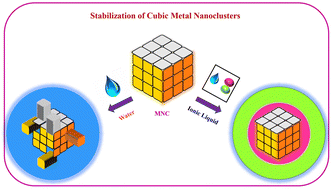
J. Mater. Chem. B, 2024,12, 3908-3916
https://doi.org/10.1039/D3TB02474A
Multifunctional nanocomposites mediated novel hydrogel for diabetic wound repair
Synthesis strategy of glucose-responsive intelligent hydrogels based on multifunctional nanocomposite nodes and their mechanism in diabetic and infected diabetic wounds.

J. Mater. Chem. B, 2024,12, 3292-3306
https://doi.org/10.1039/D3TB02283H
A ZIF-8-encapsulated interpenetrated hydrogel/nanofiber composite patch for chronic wound treatment
Designing wound dressings necessitates the crucial considerations of maintaining a moist environment and implementing effective bacterial control.

J. Mater. Chem. B, 2024,12, 2042-2053
https://doi.org/10.1039/D3TB02683C
Silver oxide decorated urchin-like microporous organic polymer composites as versatile antibacterial organic coating materials
Microporous organic polymers (MOPs) and silver oxide (Ag2O) hybrid composites do show good antimicrobial capabilities, making them flexible for a variety of applications.

J. Mater. Chem. B, 2024,12, 2054-2069
https://doi.org/10.1039/D3TB02619A
Copper(II)-infused porphyrin MOF: maximum scavenging GSH for enhanced photodynamic disruption of bacterial biofilm
A maximum GSH-depleting photodynamic nanosystem was developed by loading Cu2+ into porphyrin MOF. Both in vitro and in vivo results indicate MOF@Cu2+ could obliterate biofilm infection and facilitate wound healing with no distinct side effects.

J. Mater. Chem. B, 2024,12, 1317-1329
https://doi.org/10.1039/D3TB02577B
A potent multifunctional ZIF-8 nanoplatform developed for colorectal cancer therapy by triple-delivery of chemo/radio/targeted therapy agents
Background: Multimodal cancer therapy has garnered significant interest due to its ability to target tumor cells from various perspectives.

J. Mater. Chem. B, 2024,12, 1096-1114
https://doi.org/10.1039/D3TB02571C
Dual-mode fluorescence and electrochemiluminescence sensors based on Ru-MOF nanosheets for sensitive detection of apoE genes
A novel FL–ECL dual-mode sensor for apoE gene detection with ruthenium MOF nanosheets exhibits high sensitivity, wide linear ranges, and robust real-world application potential.

J. Mater. Chem. B, 2024,12, 701-709
https://doi.org/10.1039/D3TB01934A
Dual photoresponsive & water-triggered nitric oxide releasing materials based on rhodium-based metal–organic polyhedra
Porous materials based on robust rhodium-based metal–organic polyhedra have relevant NO payloads and release them in response to two different stimuli: light and humidity.

J. Mater. Chem. B, 2024,12, 233-239
https://doi.org/10.1039/D3TB02162A
All-in-one HN@Cu-MOF nanoparticles with enhanced reactive oxygen species generation and GSH depletion for effective tumor treatment
The multi-functional nanoparticle HN@Cu-MOF integrates PDT/CDT/GT, leading to a significant enhancement in GSH consumption and an elevation in ROS production, initiating the sensitization to PDT and cell apoptosis in the treatment of tumors.
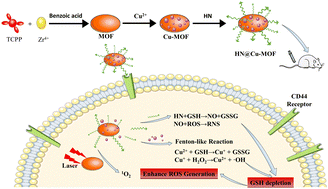
J. Mater. Chem. B, 2023,11, 11519-11531
https://doi.org/10.1039/D3TB02433D
Porphyrin–anthracene covalent organic frameworks for sustainable photosterilization
A porphyrin–anthracene covalent organic framework for continuous release of singlet oxygen through both photosensitization and cycloreversion pathways was constructed for photosterilization and bacterial-infected wound healing.

J. Mater. Chem. B, 2023,11, 11094-11102
https://doi.org/10.1039/D3TB02017G
Exploring the antimicrobial potential of isoniazid loaded Cu-based metal–organic frameworks as a novel strategy for effective killing of Mycobacterium tuberculosis
Synthesis of IITI-3, INH encapsulation within IITI-3, their drug release, anti-mycobacterial activity and the mycobacterial biofilm inhibition phenomenon of INH@IITI-3.

J. Mater. Chem. B, 2023,11, 10929-10940
https://doi.org/10.1039/D3TB02292G
A metal–organic framework complex for enhancing tumor treatments through synergistic effect of chemotherapy and photodynamic therapy
The La-TCPP@DOX@Apt composite nanomaterial not only avoid the side effects caused by high concentration chemotherapeutic drugs, but also can effectively inhibit and kill solid tumors under the synergistic attack of CD and PDT.

J. Mater. Chem. B, 2023,11, 10706-10716
https://doi.org/10.1039/D3TB01592K
Rational design of copper(I)-doped metal–organic frameworks as dual-functional nanocarriers for combined chemo–chemodynamic therapy
A dual-functional nanocarrier was constructed via in situ crystallization with DOX drugs covalently connected to the surface of CuZn-ZIF for combining chemotherapy and chemodynamic therapy.

J. Mater. Chem. B, 2023,11, 10632-10639
https://doi.org/10.1039/D3TB01869E
PEGylation of a shell over core–shell MOFs—a novel strategy for preventing agglomeration and synergism in terms of physicochemical and biological properties
A new strategy of PEGylation over core–shell MOFs of HKUST-1 and Cu-MOF-2 by a solvothermal method.

J. Mater. Chem. B, 2023,11, 10665-10677
https://doi.org/10.1039/D3TB01125A
Gallium-based metal–organic frameworks loaded with antimicrobial peptides for synergistic killing of drug-resistant bacteria
One-step synthesis of gallium-based metal–organic frameworks loaded with antimicrobial peptides at room temperature for synergistic killing of drug-resistant bacteria.

J. Mater. Chem. B, 2023,11, 10446-10454
https://doi.org/10.1039/D3TB01754K
Exploring the potential of iron-based metal–organic frameworks as peroxidase nanozymes for glucose detection with various secondary building units
This study investigated different secondary building units of iron-based metal–organic frameworks and discovered that when combined with an enzyme-encapsulating ZIF-90 PVP MOF, they could be sequentially employed for glucose detection purposes.

J. Mater. Chem. B, 2023,11, 10362-10368
https://doi.org/10.1039/D3TB00981E
Wool keratin/zeolitic imidazolate framework-8 composite shape memory sponge with synergistic hemostatic performance for rapid hemorrhage control
By combining the keratin and ZIF-8 particles, the problems of the poor mechanical properties and lack of antibacterial effect of the keratin sponge was solved. The released by Zn2+ form ZIF-8 acted as crosslinker to form Zn-S with sulfhydryl groups.

J. Mater. Chem. B, 2023,11, 10234-10251
https://doi.org/10.1039/D3TB01660A
Dual ligand-assisted assembly of metal–organic frameworks on upconversion nanoparticles for NIR photodynamic therapy against hypoxic tumors
The dual ligand functionalization of UCNP and MOF assembly on multiple UCNPs to obtain nanohybrid UCMs.

J. Mater. Chem. B, 2023,11, 9516-9524
https://doi.org/10.1039/D3TB01398G
Green synthesis of metal–organic framework loaded dexamethasone on wood aerogels for enhanced cranial bone regeneration
The research direction of this manuscript is focused on osteogenesis through zeolitic imidazolate framework-8 (ZIF-8) loaded dexamethasone DEX. It is shown that DEX can induce osteogenic differentiation of rat bone marrow mesenchymal stem cells and promote osteogenesis in vitro and in vivo.

J. Mater. Chem. B, 2023,11, 9496-9508
https://doi.org/10.1039/D3TB01484C
Hierarchical mesoporous NanoMUV-2 for the selective delivery of macromolecular drugs
NanoMUV-2 stores high payloads of Paclitaxel and increases its anticancer selectivity.

J. Mater. Chem. B, 2023,11, 9179-9184
https://doi.org/10.1039/D3TB01819A
A novel PEC and ECL bifunctional aptasensor based on V2CTx MXene-derived MOF embedded with silver nanoparticles for selectively aptasensing miRNA-126
A novel PEC and ECL bifunctional biosensor for the sensitive and selective detection of miRNA-126 based on the AgNPs@V-PMOF Schottky heterojunction was constructed.
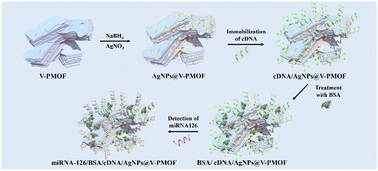
J. Mater. Chem. B, 2023,11, 8657-8665
https://doi.org/10.1039/D3TB01380D
Hydrogen-bonded organic framework-stabilized charge transfer cocrystals for NIR-II photothermal cancer therapy
Within hydrogen-bonded organic frameworks (HOFs), the stabilized charge transfer cocrystals, named TQC@PFC-1, exhibit high photothermal conversion efficiency in the NIR II region for photothermal therapy in both in vitro and in vivo settings.
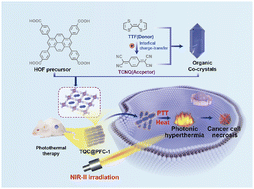
J. Mater. Chem. B, 2023,11, 8649-8656
https://doi.org/10.1039/D3TB01475D
A metal–organic framework-based fluorescence resonance energy transfer nanoprobe for highly selective detection of Staphylococcus Aureus
We report a nanoprobe for highly sensitive detection of S. aureus, relying on a MOF-based FRET process.

J. Mater. Chem. B, 2023,11, 8519-8527
https://doi.org/10.1039/D3TB01428B
Construction of Fe-doped ZIF-8/DOX nanocomposites for ferroptosis strategy in the treatment of breast cancer
The DOX@7FZ was able to enhance the ROS level in cancer cells via a synergistic effect between apoptosis/ferroptosis synergism.
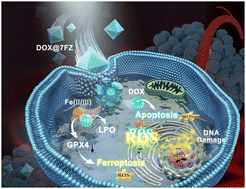
J. Mater. Chem. B, 2023,11, 6335-6345
https://doi.org/10.1039/D3TB00749A
About this collection
Synthetic porous materials such as metal-organic frameworks (MOFs) and covalent organic frameworks (COFs) exhibit unique properties, for example, size-controlled synthesis, geometrically and chemically tuneable pore spaces, very high internal molecular storage capacities, and addressable particle surfaces. For these reasons, functional framework materials such as MOFs and COFs have been extensively investigated for a wide range of applications. Furthermore, the ability to judiciously select structural components with both biocompatibility and functionality has led to the study of these materials across all aspects of nanomedicine, from drug delivery to radiotherapies, imaging, theranostics, and beyond. Notable breakthroughs are typically underpinned by fundamental advances in materials synthesis, functionalisation, and characterisation, as well as interdisciplinary approaches examining biocompatibility, imaging methodologies, and biological mechanisms of therapeutic action, ensuring a broad scientific interest.
This collection in Journal of Materials Chemistry B guest edited by Prof. Ross Forgan (University of Glasgow, UK), Dr Ruxandra Gref (Université Paris Saclay, France) and Prof. Jianqiang Liu (Guangdong Medical University, China) covers all aspects of MOF and COF chemistry related to biological applications. The collection will provide a platform to highlight state-of-the-art developments in a rapidly moving field, including but not limited to, drug delivery (from small molecules through peptides and oligonucleotides to large proteins), all aspects of imaging, theranostics, biological sensing, biocompatibility in vitro and in vivo, hybridisation with other nanomaterials, encapsulation of biological entities (from enzymes to viruses and cells), and other emerging technologies. We hope that this themed collection will bring together the state-of-the-art in the field in one place, acting as a valuable resource for those entering the field while highlighting the huge potential of functional framework materials in biomedicine.